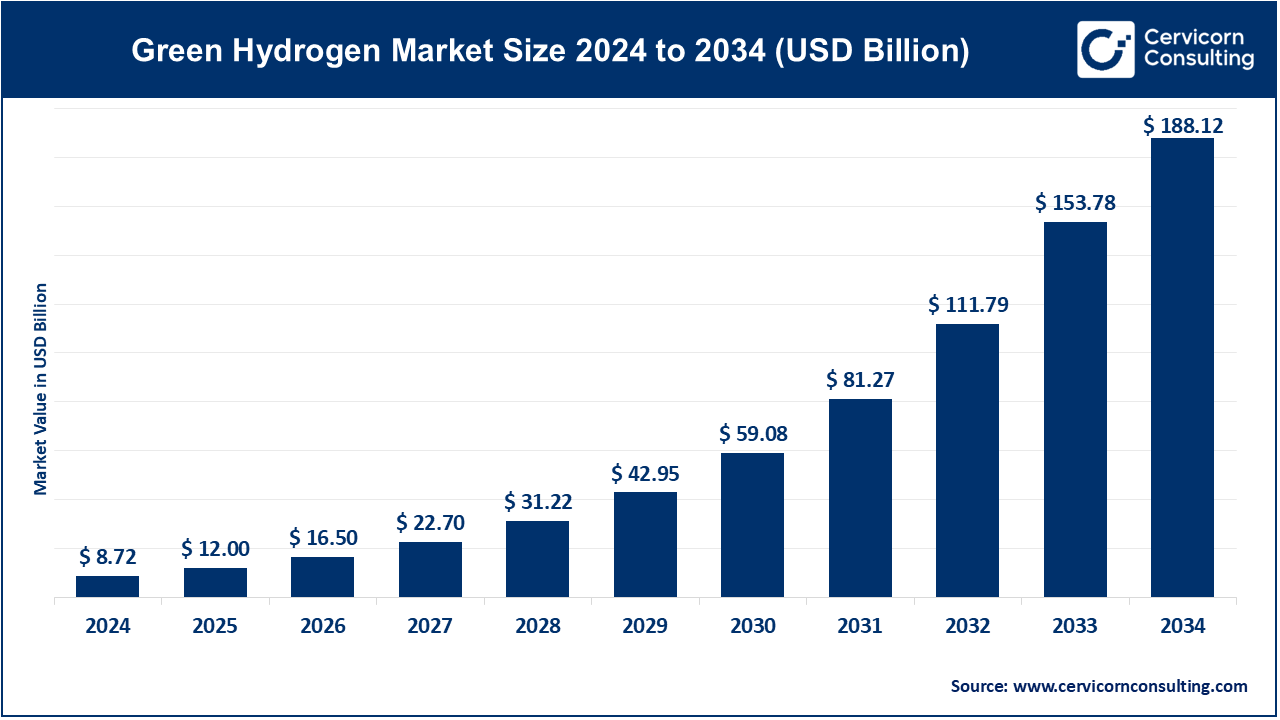Green Hydrogen Market Overview
The global green hydrogen market is experiencing remarkable growth, fueled by the increasing global focus on clean energy and decarbonization initiatives. In 2024, the market was valued at approximately USD 8.72 billion and is expected to expand significantly, potentially surpassing USD 188.12 billion by 2034, registering a CAGR of over 35.95%. Produced via electrolysis using renewable energy sources such as solar, wind, and hydropower, green hydrogen offers a zero-emission alternative to traditional fossil fuel-based hydrogen, making it a vital component for achieving worldwide net-zero objectives.
Key Market Trends
1. Advancements in Electrolyzer Technology
Innovation in electrolyzers, including PEM (Proton Exchange Membrane) and alkaline systems, has improved efficiency, lowered costs, and enabled industrial-scale adoption. Companies like ITM Power and Nel ASA are deploying modular electrolyzer solutions to support applications ranging from mobility to industrial feedstock.
2. Government Incentives and Policy Support
Global governments are implementing policies and subsidies to drive green hydrogen adoption. For instance, the US Hydrogen Energy Earthshot initiative aims to reduce hydrogen production costs to USD 1/kg by 2030, while the European Union Hydrogen Strategy funds infrastructure development and R&D programs.
3. Hydrogen Mobility Integration
Green hydrogen is increasingly being incorporated into the transport sector, particularly for heavy-duty vehicles, buses, and fuel cell trains. Regions like Japan and Europe are expanding hydrogen-powered mobility, driving demand for hydrogen and supporting the growth of refueling infrastructure.
4. Cross-Sector Industrial Applications
Industries that are difficult to decarbonize, such as steel, ammonia, and chemical manufacturing, are turning to green hydrogen as a replacement for fossil fuels. This shift reduces carbon emissions and strengthens energy security.
5. Emergence of Hydrogen Hubs and Ecosystems
Integrated hydrogen hubs, such as Hydrogen Valley (Netherlands) and the NEOM Green Hydrogen Project (Saudi Arabia), showcase large-scale production, storage, and distribution. These hubs stimulate local demand, create export opportunities, and attract both private and public investments.
Market Drivers
-
Global Decarbonization Goals: Net-zero emission targets by governments and corporations are creating strong demand for green hydrogen.
-
Renewable Energy Expansion: Growing investments in wind, solar, and hydropower provide affordable electricity for hydrogen production.
-
Industrial Demand: Adoption in steel, ammonia, and chemical sectors drives market growth, with ammonia production representing a substantial share of global hydrogen consumption.
-
Technological Advancements: Improvements in electrolyzer efficiency and cost reduction strategies make green hydrogen more competitive with grey hydrogen.
-
Policy Support and Incentives: Subsidies, tax credits, and funding programs in North America, Europe, and Asia accelerate adoption and infrastructure development.
Impact of Trends and Drivers
-
North America: Government programs like hydrogen hubs and cost-reduction initiatives are accelerating adoption in both industrial and mobility sectors.
-
Europe: Supportive policies and investment in large-scale electrolysis projects promote renewable hydrogen integration across steel, chemical, and transport sectors.
-
Asia-Pacific: Countries such as Japan and China focus on hydrogen mobility and fuel cell deployment, driving regional demand.
-
Middle East & Latin America: Countries leverage abundant solar and wind resources to produce green hydrogen for domestic use and exports.
These drivers and trends are catalyzing adoption across multiple sectors, including mobility, power generation, and industrial feedstock applications.
Challenges & Opportunities
Challenges: High production costs, limited infrastructure, and technology standardization remain significant hurdles.
Opportunities: Reduced electrolyzer costs, expanding hydrogen export markets, and supportive government policies offer substantial growth potential. Collaborative efforts between governments, energy firms, and technology providers are fostering a favorable environment for expansion.
Future Outlook
The global green hydrogen market is poised for rapid growth over the next decade, with a projected CAGR exceeding 30%. Increasing investments in renewable energy, rising industrial demand, and government support are expected to drive market expansion. Emerging trends, including hydrogen mobility, industrial integration, and large-scale hydrogen hubs, will continue to shape the market, establishing green hydrogen as a cornerstone of the global energy transition.
📌 Contact Us for Full Market Overview: https://www.cervicornconsulting.com/contact-us


